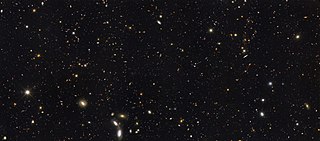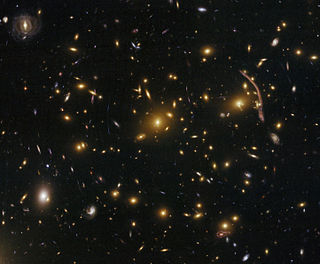
Fornax is a constellation in the southern celestial hemisphere, partly ringed by the celestial river Eridanus. Its name is Latin for furnace. It was named by French astronomer Nicolas Louis de Lacaille in 1756. Fornax is one of the 88 modern constellations.

A galaxy cluster, or a cluster of galaxies, is a structure that consists of anywhere from hundreds to thousands of galaxies that are bound together by gravity, with typical masses ranging from 1014 to 1015 solar masses. They are the second-largest known gravitationally bound structures in the universe after galaxy filaments and were believed to be the largest known structures in the universe until the 1980s, when superclusters were discovered. One of the key features of clusters is the intracluster medium (ICM). The ICM consists of heated gas between the galaxies and has a peak temperature between 2–15 keV that is dependent on the total mass of the cluster. Galaxy clusters should not be confused with galactic clusters (also known as open clusters), which are star clusters within galaxies, or with globular clusters, which typically orbit galaxies. Small aggregates of galaxies are referred to as galaxy groups rather than clusters of galaxies. The galaxy groups and clusters can themselves cluster together to form superclusters.

The Hubble Deep Field (HDF) is an image of a small region in the constellation Ursa Major, constructed from a series of observations by the Hubble Space Telescope. It covers an area about 2.6 arcminutes on a side, about one 24-millionth of the whole sky, which is equivalent in angular size to a tennis ball at a distance of 100 metres. The image was assembled from 342 separate exposures taken with the Space Telescope's Wide Field and Planetary Camera 2 over ten consecutive days between December 18 and 28, 1995.

The Hubble Ultra-Deep Field (HUDF) is a deep-field image of a small region of space in the constellation Fornax, containing an estimated 10,000 galaxies. The original data for the image was collected by the Hubble Space Telescope from September 2003 to January 2004. It includes light from galaxies that existed about 13 billion years ago, some 400 to 800 million years after the Big Bang.

NASA's series of Great Observatories satellites are four large, powerful space-based astronomical telescopes launched between 1990 and 2003. They were built with different technology to examine specific wavelength/energy regions of the electromagnetic spectrum: gamma rays, X-rays, visible and ultraviolet light, and infrared light.

The Hubble Deep Field South is a composite of several hundred individual images taken using the Hubble Space Telescope's Wide Field and Planetary Camera 2 over 10 days in September and October 1998. It followed the great success of the original Hubble Deep Field in facilitating the study of extremely distant galaxies in early stages of their evolution. While the WFPC2 took very deep optical images, nearby fields were simultaneously imaged by the Space Telescope Imaging Spectrograph (STIS) and the Near Infrared Camera and Multi-Object Spectrometer (NICMOS).

The Extended Groth Strip is an image of a small region between the constellations of Ursa Major and Boötes, based on the results of a series of observations by the Hubble Space Telescope. It covers an area 70 arcminutes across and 10 arcminutes wide, which correlates to a patch of sky roughly the width of a finger stretched at arm's length. The image was assembled from over 500 separate exposures taken with the Space Telescope's Advanced Camera for Surveys at 63 different pointings, spread out over the course of one year from June 2004 to March 2005. The complete image at the highest resolution in JPEG format is nearly 250 megabytes.

NGC 1427A is an irregular galaxy in the constellation Fornax. Its distance modulus has been estimated using the globular cluster luminosity function to be 31.01 ± 0.21 which is about 52 Mly. It is the brightest dwarf irregular member of the Fornax cluster and is in the foreground of the cluster's central galaxy NGC 1399.

The Great Observatories Origins Deep Survey, or GOODS, is an astronomical survey combining deep observations from three of NASA's Great Observatories: the Hubble Space Telescope, the Spitzer Space Telescope, and the Chandra X-ray Observatory, along with data from other space-based telescopes, such as XMM Newton, and some of the world's most powerful ground-based telescopes.

Abell 370 is a galaxy cluster located nearly 5 billion light-years away from the Earth, in the constellation Cetus. Its core is made up of several hundred galaxies. It was catalogued by George Abell, and is the most distant of the clusters he catalogued.

The Chandra Deep Field South (CDF-S) is an image taken by the Chandra X-ray Observatory satellite. The location was chosen because, like the Lockman Hole, it is a relatively clear "window" through the ubiquitous clouds of neutral hydrogen gas in the Milky Way galaxy, which allows observers to clearly see the rest of the universe in X-rays. The image is centered on RA 3h 32m 28.0s DEC −27° 48′ 30″ (J2000.0), covering 0.11 square degrees, measuring 16 arcminutes across. This patch of sky lies in the Fornax constellation.

MACS J0717.5+3745 is a large galaxy cluster located 5.4 billion light years away in the constellation Auriga, appearing in the Massive Cluster Survey (MACS).

HUDF-JD2 is a distant, massive, post-starburst galaxy that was discovered with the Hubble Ultra Deep Field (HUDF) image. It was the most distant galaxy identified in the HUDF, in 2005. It is located at 03h 32m 38.7268s −27° 48′ 39.885″ in the constellation of Fornax.

Bedin I is a dwarf spheroidal galaxy located in the constellation Pavo. It is situated around 28.38 million light-years from Earth, behind the globular cluster NGC 6752. Bedin I is possibly one of the oldest galaxies known, having formed around 10–13 billion years ago, and is one of the most isolated dwarf galaxies known, situated around 2.12 million light-years away from NGC 6744, its nearest neighbor with which it may be physically associated. As such, it has been deemed by astronomers as a "fossil" from the early universe. It was accidentally discovered by Italian astronomer Luigi Bedin, whose team was studying white dwarfs in NGC 6752 using the Hubble Space Telescope in September 2018; the discovery was announced in a paper published in January 2019.

NGC 547 is an elliptical galaxy and radio galaxy located in the constellation Cetus. It is located at a distance of circa 220 million light years from Earth, which, given its apparent dimensions, means that NGC 547 is about 120,000 light years across. It was discovered by William Herschel on October 1, 1785. It is a member of the Abell 194 galaxy cluster and is included along with NGC 547 in the Atlas of Peculiar Galaxies.
Touch the Invisible Sky is a 60-page tactile astronomy book written by astronomy educator Noreen Grice, and astronomers Simon Steel and Doris Daou, and was published in 2007 by Ozone publishing. The book contains colour images alongside Braille and large print descriptions of celestial objects, and colour photographs from the Hubble Space Telescope, Chandra X-Ray Observatory, and Spitzer Space Telescope, amongst others, which are over-laid with TechnoBraille, allowing visually impaired readers to feel the images. The images featured include nebulae, stars, galaxies and some of the telescopes used to photograph the celestial objects. The images span a range of wavelengths on the electromagnetic spectrum, with a variety of textures and shapes used to convey the characteristics of the objects. The objects featured include our own Sun, the star Eta Carinae, The Crab Nebula, and Kepler's Supernova.

Webb's First Deep Field is the first operational image taken by the James Webb Space Telescope. The deep-field photograph, which covers a tiny area of sky visible from the Southern Hemisphere, is centered on SMACS 0723, a galaxy cluster in the constellation of Volans. Thousands of galaxies are visible in the image, some as old as 13 billion years. The image is the highest-resolution image of the early universe ever taken. Captured by the telescope's Near-Infrared Camera (NIRCam), the image was revealed to the public by NASA on 11 July 2022.

SMACS J0723.3–7327, commonly referred to as SMACS 0723, is a galaxy cluster about 4 billion light years from Earth, within the southern constellation of Volans. It is a patch of sky visible from the Southern Hemisphere on Earth and often observed by the Hubble Space Telescope and other telescopes in search of the deep past. It was the target of the first full-color image to be unveiled by the James Webb Space Telescope (JWST), imaged using NIRCam, with spectra included, showing objects lensed by the cluster with redshifts implying they are 13.1 billion years old. The cluster has been previously observed by the Hubble Space Telescope (HST) as part of the Southern MAssive Cluster Survey (SMACS), as well as Planck and Chandra.



















